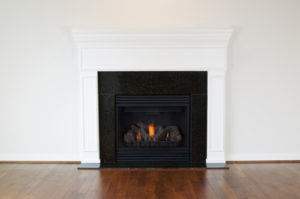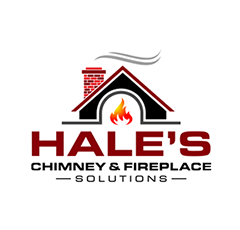When it comes to fireplaces, many people desire the warm, cozy atmosphere that one can bring to their home. However, owning a fireplace comes with a lot of work. With wood fireplaces,  you need to collect, chop, season, stack, and haul wood just to be able to operate your fireplace. This, coupled with the maintenance and upkeep that is required with owning a wood-burning fireplace can turn homeowners off to owning a fireplace entirely. However, did you know that there are fireplace options available to homeowners that don’t require nearly all of the work and maintenance that come with owning and operating a wood fireplace? At Hale’s Chimney & Fireplace Solutions, we offer a variety of gas log, gas insert, and gas fireplace appliances for homeowners. So, if you aren’t sure that a wood-burning fireplace is right for you, let us tell why a gas fireplace could be exactly what you are looking for.
you need to collect, chop, season, stack, and haul wood just to be able to operate your fireplace. This, coupled with the maintenance and upkeep that is required with owning a wood-burning fireplace can turn homeowners off to owning a fireplace entirely. However, did you know that there are fireplace options available to homeowners that don’t require nearly all of the work and maintenance that come with owning and operating a wood fireplace? At Hale’s Chimney & Fireplace Solutions, we offer a variety of gas log, gas insert, and gas fireplace appliances for homeowners. So, if you aren’t sure that a wood-burning fireplace is right for you, let us tell why a gas fireplace could be exactly what you are looking for.
Gas as a Fuel
Gas appliances run on natural gas or propane. There are many upsides to owning a gas appliance compared to a wood-burning one. Gas burns very efficiently, meaning that there are very little byproducts produced when it is burned. While wood can produce a lot of byproducts in the form of smoke, soot, and creosote, gas produces only minuscule amounts of byproducts. This has two major effects. First, since a larger percentage of your fuel is being converted to heat, you are getting more bang for your buck with your fuel efficiency. Second, less byproduct means less creosote build up in your flue. This can save homeowners a lot of money on maintenance and sweeping costs.
Why Gas
One of the most common reasons that homeowners decide to install a gas appliance is ease of use. A gas appliance doesn’t require the chopping, stacking, seasoning, hauling, and storing of wood that is required with a wood-burning appliance. In fact, most gas appliances turn on with a flip of a switch or a remote. You also can control gas heat a lot better than you can a wood-burning fireplace, so it’s better for managing your home’s heating needs. Also, depending on your location, wood fuel can be a scarce or a rather expensive fuel source.
Types of Installations
There are typically three types of gas installations that we perform at Hale’s Chimney & Fireplace Solutions: gas logs, inserts, and fireplaces. Each one of these installations has its own advantage depending on the homeowner’s heating needs, preferences, and current set up.
- Gas Logs – A gas log set consists of installing a natural gas or propane burner in an already existing fireplace’s firebox. [http://www.csia.org/gas_logs.html] Next, a set of realistic looking, ceramic logs are installed on top of the burner, giving it the appearance of a real wood fire. Similar to a real wood fire, gas logs are valued for the ambiance they create. Also similar to wood fires, they don’t produce nearly as much heat as a gas insert or fireplace would create. Gas log sets require the same ventilation as a wood fireplace, however, gas doesn’t produce as much creosote as wood, saving you time and maintenance costs.
- Inserts – An insert is an appliance that is inserted into an already existing open-hearth fireplace’s firebox, taking the place of your old firebox. Inserts are designed in such a way that they retain more of the heat from your fire, pushing that heat into the home, instead of up and out of your chimney. This means that they are a lot more heat efficient than your normal open-hearth, wood-burning fireplaces or gas logs. Inserts are extremely handy if you want to change the type of fuel that you want to burn. This is because a gas insert can be placed inside a wood-burning firebox, essentially converting it from a wood to a gas-burning appliance.
- Fireplaces – If you don’t have a fireplace already, We here at Hale’s Chimney and Fireplace Solutions can install a new one for you. Gas fireplaces take a lot less time, space, and money to install than a wood-burning masonry fireplace. Because of this, gas fireplaces allow for a lot of different options in regards to placement within a home.
Servicing Gas
Although gas fireplaces burn a lot cleaner and more efficiently than wood fireplaces, they still require annual inspections. Gas appliances have different maintenance needs and there are still hazards related to gas leaks and carbon monoxide leaks that need to be checked. It is also important to make sure that the chimney technician performing your inspection is certified by the Chimney Safety Institute of America (CSIA). Only a CSIA certified technician, like the ones at Hale’s Chimney and Fireplace Solutions, have the expertise to make sure your inspection was done correctly, with your family’s safety in mind. If you are in the market for a new gas fireplace, call Hale’s Chimney and Fireplace Solutions today at 972-563-6851 or contact us online to talk with one of our gas fireplace experts. We look forward to serving you!
